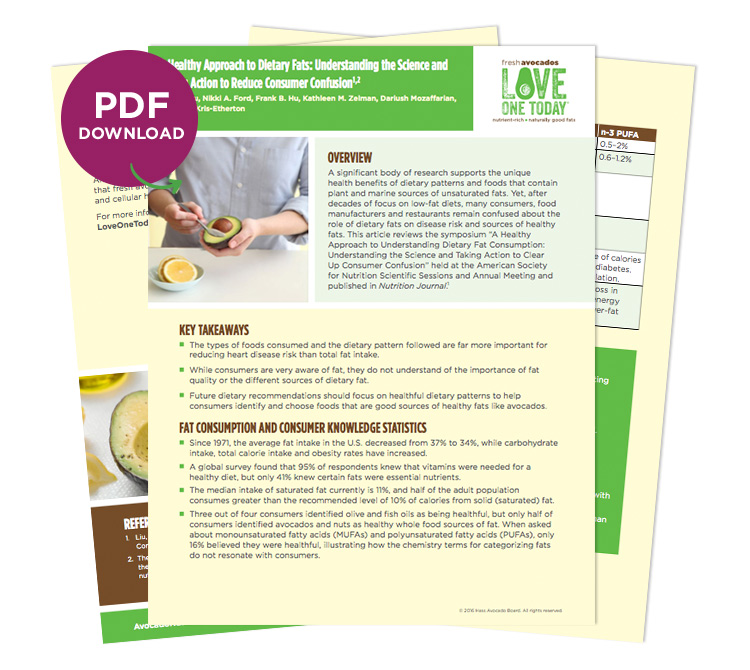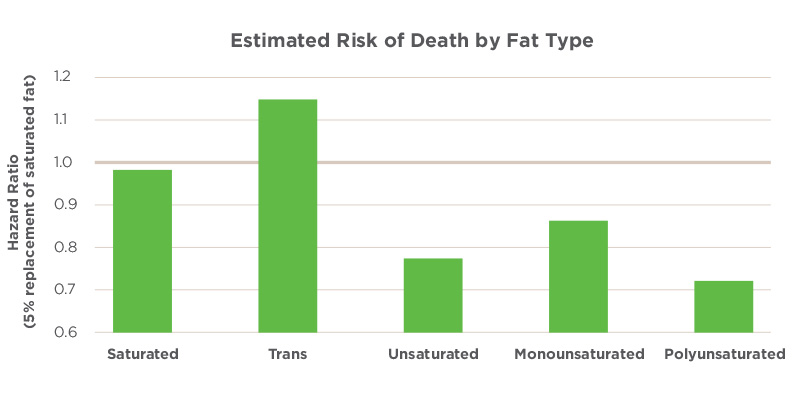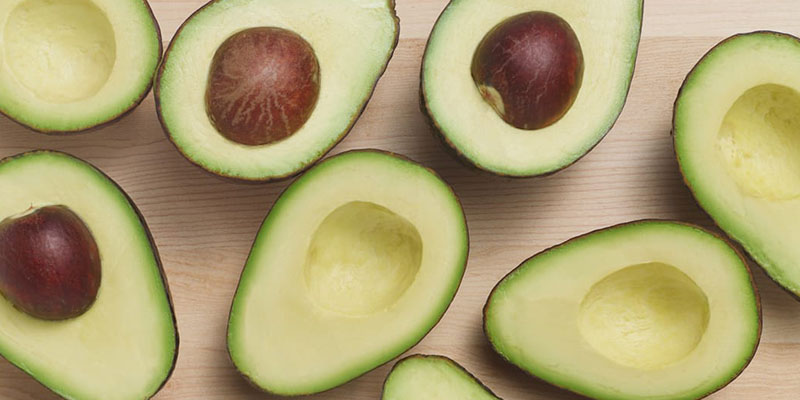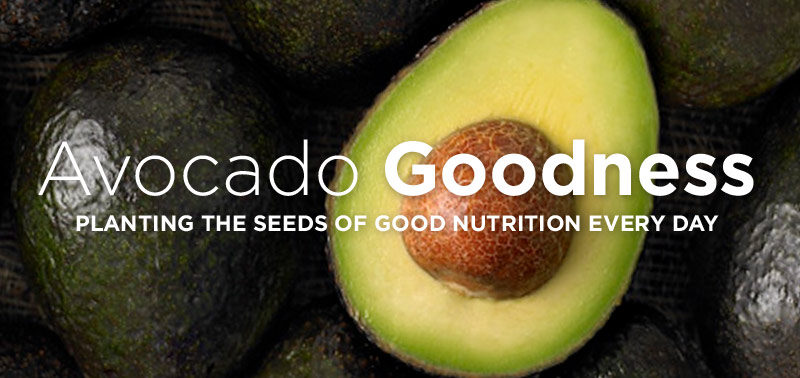Study Overview
A significant body of research supports the unique health benefits of dietary patterns and foods that contain plant and marine sources of unsaturated fats. Yet, after decades of focus on low-fat diets, many consumers, food manufacturers and restaurants remain confused about the role of dietary fats on disease risk and sources of healthy fats. This article reviews the symposium “A Healthy Approach to Understanding Dietary Fat Consumption: Understanding the Science and Taking Action to Clear Up Consumer Confusion” held at the American Society for Nutrition Scientific Sessions and Annual Meeting and published in Nutrition Journal.1
Published: Nutrition Journal 2017
Study funded by Hass Avocado Board
Category: Cardiovascular Health, Healthy Living at Every Age, Type 2 Diabetes
Download Scientific Summary PDF
See Published Study
Key Takeaways
The types of foods consumed and the dietary pattern followed are far more important for reducing heart disease risk than total fat intake.
While consumers are very aware of fat, they do not understand the importance of fat quality or the different sources of dietary fat.
Future dietary recommendations should focus on healthful dietary patterns to help consumers identify and choose foods that are good sources of healthy fats like avocados.
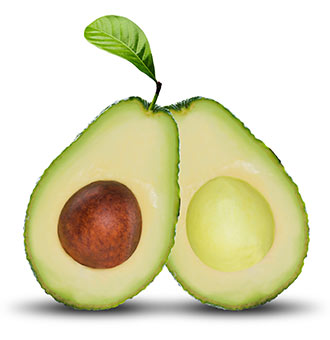
Fat Consumption and Consumer Knowledge Statistics
- Since 1971, the average fat intake in the U.S. decreased from 37% to 34%, while carbohydrate intake, total calorie intake and obesity rates have increased.
- A global survey found that 95% of respondents knew that vitamins were needed for a healthy diet, but only 41% knew certain fats were essential nutrients.
- The median intake of saturated fat currently is 11%, and half of the adult population consumes greater than the recommended level of 10% of calories from solid (saturated) fat.
- Three out of four consumers identified olive and fish oils as being healthful, but only half of consumers identified avocados and nuts as healthy whole food sources of fat. When asked about monounsaturated fatty acids (MUFAs) and polyunsaturated fatty acids (PUFAs), only 16% believed they were healthful, illustrating how the chemistry terms for categorizing fats do not resonate with consumers.
Dietary Fat Nutrition Research

Data from the Nurses’ Health Study and Health Professional Follow-up Study estimate that replacing 5% of calories from solid fat with MUFA is associated with a 15% lower risk of coronary heart disease. Consuming unsaturated fats in place of saturated fat reduces total mortality and death from cardiovascular disease, cancer and neurodegenerative disease.
Over 75% of the fat in avocados is good fat, with 5 grams coming from MUFA and 1 gram from PUFA per 50 grams serving.

After 4.8 years in the PREDIMED trial, consumption of a Mediterranean diet supplemented with either extra-virgin olive oil or nuts resulted in a 30% reduction in risk of myocardial infarction, stroke or death, and a 52% reduction in diabetes incidence. A Mediterranean diet also reduced diastolic blood pressure, 24-hour ambulatory blood pressure, fasting blood glucose, total cholesterol and biomarkers of vascular wall in ammation.
Although they are not native to Mediterranean countries, fresh avocados are a unique fruit which provide a good source of fiber and naturally good fats, a hallmark of the Mediterranean style of eating.

In the OmniHeart, high-carbohydrate, high-protein and high-MUFA diets all improved blood pressure and LDL compared to baseline, but the diets that replaced saturated fat with protein or especially vegetable-based unsaturated fats most improved cardiovascular disease risk factors.
Swap avocado in place of unhealthy spreads, dips or use as a 1:1 substitute for saturated fats in baked goods.
Current Dietary Fat Intake
Recommendations for Adults
Recommended Percent of Energy
World Health Organization
Total Fat: 20–35%
Saturated Fat: <10%
Trans Fat: <1%
n-6 PUFA: 2.5–9%
n-3 PUFA: 0.5–2%
Food and Nutrition Board, Institute of Medicine
Total Fat: 20–35%
Saturated Fat: Limit
Trans Fat: Limit
n-6 PUFA: 5–10%
n-3 PUFA: 0.6–1.2%
U.S. Department of Health & Human Services and U.S. Department of Agriculture
Total Fat: —
Saturated Fat: <10%
Trans Fat: Limit
n-6 PUFA: —
n-3 PUFA: —
American Heart Association/American College of Cardiology
Total Fat: —
Saturated Fat: 5-6%
Trans Fat: Limit
n-6 PUFA: —
n-3 PUFA: —
American Diabetes Association
Evidence suggests that there is not an ideal percentage of calories from carbohydrate, protein and fat for all people with diabetes. Follow same recommendation as for the general population.
American College of Cardiology/American Heart Association/ The Obesity Society
A variety of dietary approaches can produce weight loss in overweight and obese adults as long as reduction in energy intake is achieved. Weight loss is comparable with lower-fat and higher-fat diets.
Communicating the Science
- Condense complex information into motivating messages, but keep them evidence based.
- Use language at the 6-8th grade reading level that is clear and easy to understand. The best messages are actionable, easy to implement and easy to visualize.
- Put research findings in context within the prevailing body of evidence and avoid sensational headlines.
- Work with reporters to make sure your comments and quotes are correct.
- Have a few (e.g., three) key messages that consumers can remember and reinforce with a strong bottom line.
- Specify practical dietary substitutions with a “compared to what” approach rather than general “eat more/less.”
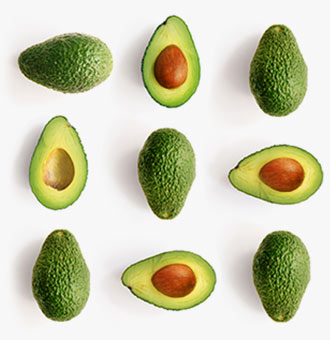
1.Liu, et al. A Healthy Approach to Dietary Fats: Understanding the Science and Taking Action to Reduce Consumer Confusion. Nutrition Journal 2017.
2.The avocado nutritional information throughout this summary has been updated to reflect changes by the FDA to the avocado serving size on July 26, 2016. (More info on Nutrition Health Facts and Label)

